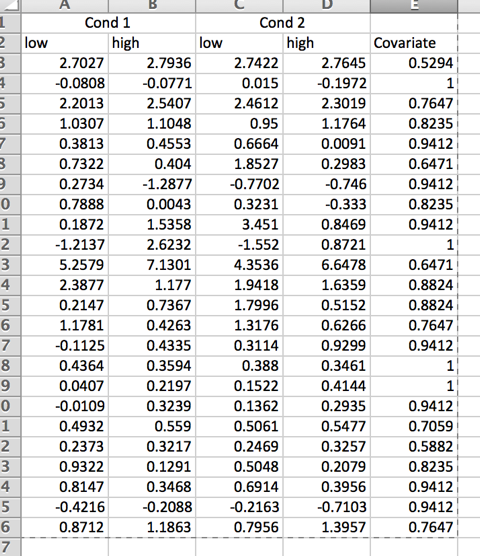First, you aren't really "testing for homogeneity"; you are testing for an interaction, it seems.
One option for a solution is a linear mixed model. You need to reshape the data from wide to long format first. And then you can run a model predicting the outcome variable (measurement) by the condition (cond), level (level), and covariate (cov). Code is below. I specified cond and level to be random effects, but you could try to specify the random effects structure differently with different nested model comparisons (I laid out elsewhere here).
You could also do a within-subjects ANCOVA, but I prefer linear mixed models. They are more flexible and can handle when the covariate is related to the other factors (I'm not sure if the other factors were measured or manipulated).
> widedat <- read.csv("/Users/markiiwhite/Downloads/dat.csv") # reading in data
> widedat$id <- as.factor(dat$id) # making id a factor
> head(widedat) # checking out data
id c1lo c1hi c2lo c2hi cov
1 1 2.7027 2.7936 2.7422 2.7645 0.5294
2 2 -0.0808 -0.0771 0.0150 -0.1972 1.0000
3 3 2.2013 2.5407 2.4612 2.3019 0.7647
4 4 1.0307 1.1048 0.9500 1.1764 0.8235
5 5 0.3813 0.4553 0.6664 0.0091 0.9412
6 6 0.7322 0.4040 1.8527 0.2983 0.6471
>
> library(tidyr) # loading package to convert to long format
> longdat <- gather(data=widedat, key="condition", value="measurement",
+ c(c1lo, c1hi, c2lo, c2hi), factor_key=TRUE) # converts data from wide to long...
> # ...responses in each condition (condition 1 hi, condition 2 hi, condition 1 lo, condition 2 lo)...
> # ...recoded into a value named "measurement," with a key variable called "cond"
> longdat$cond <- factor(ifelse(longdat$condition=="c1lo" | longdat$condition=="c1hi", "one", "two"))
> longdat$level <- factor(ifelse(longdat$condition=="c1lo" | longdat$condition=="c2lo", "low", "high"))
> # condition into two factors: cond and level
> longdat <- longdat[,-3] # getting rid of superfluous condition variable
> head(longdat[order(longdat$id),]) # matches the values of the data above
id cov measurement cond level
1 1 0.5294 2.7027 one low
25 1 0.5294 2.7936 one high
49 1 0.5294 2.7422 two low
73 1 0.5294 2.7645 two high
2 2 1.0000 -0.0808 one low
26 2 1.0000 -0.0771 one high
>
> library(lmerTest) # loading package for satterthwaite dfs
> library(lme4) # package for multilevel models
> model <- lmer(measurement ~ cond + level + cond*level + cov + (1 + cond + level|id), longdat)
> # measurement predicted by condition (1 or 2), level (high or low), and the covariate (cov)
> # specified random effects for cond and level, nested within id
> summary(model)
Linear mixed model fit by REML
t-tests use Satterthwaite approximations to degrees of freedom ['lmerMod']
Formula: measurement ~ cond + level + cond * level + cov + (1 + cond + level | id)
Data: longdat
REML criterion at convergence: 226.7
Scaled residuals:
Min 1Q Median 3Q Max
-2.9676 -0.3400 -0.0879 0.2729 3.2985
Random effects:
Groups Name Variance Std.Dev. Corr
id (Intercept) 1.98441 1.4087
condtwo 0.07425 0.2725 -0.50
levellow 0.64150 0.8009 -0.75 0.95
Residual 0.19626 0.4430
Number of obs: 96, groups: id, 24
Fixed effects:
Estimate Std. Error df t value Pr(>|t|)
(Intercept) 5.3721 1.3261 23.2600 4.051 0.000486 ***
condtwo -0.1114 0.1395 46.8600 -0.799 0.428558
levellow -0.1631 0.2076 34.0900 -0.786 0.437314
cov -5.2231 1.5316 22.0800 -3.410 0.002499 **
condtwo:levellow 0.2675 0.1809 46.0000 1.479 0.146004
---
Signif. codes: 0 ‘***’ 0.001 ‘**’ 0.01 ‘*’ 0.05 ‘.’ 0.1 ‘ ’ 1
Correlation of Fixed Effects:
(Intr) condtw levllw cov
condtwo -0.088
levellow -0.158 0.580
cov -0.974 0.000 0.000
cndtw:lvllw 0.034 -0.648 -0.436 0.000

